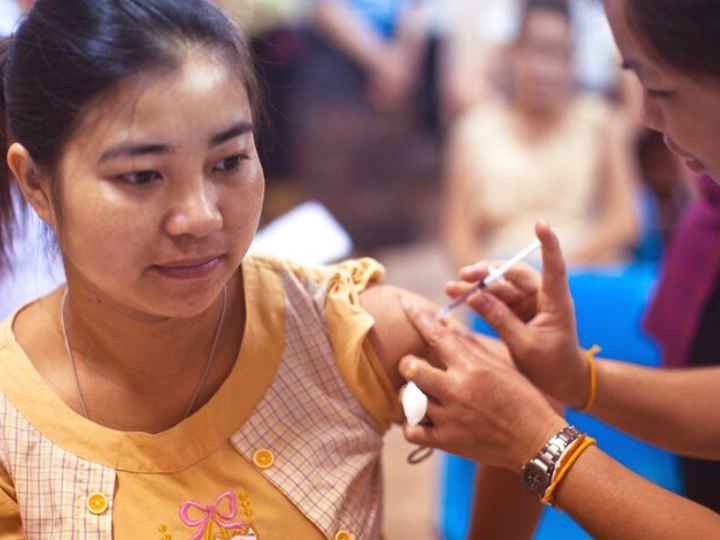
Some Americans still say no to getting any COVID-19 vaccination even as others are currently committing to their fourth shot. What accounts for differences in attitude between the fully vaccinated and those who opt out? The biggest factor could be political ideology, a new survey from the University of Houston shows.
“COVID-19 Vaccine Hesitancy: Two Years After the Outbreak,” a report released today by the UH Hobby School of Public Affairs, shows two other factors – financial compensation and CDC approval of the vaccine – also played roles in motivating survey respondents to get the shots, although to a lesser degree than individual ideological leanings. In addition, investigators identified political-party affiliation as the biggest influencer of where participants turn for information about the COVID-19 pandemic and its vaccines.
“Survey respondents who described themselves as conservative are the most hesitant toward the COVID-19 vaccine, while those who described themselves as liberal are more likely to have already received the vaccine plus one or both boosters,” said Agustín Vallejo, post-doctoral fellow with the UH Hobby School of Public Affairs and one of the lead researchers in the study.
When it comes to overall attitudes, the already-vaccinated gave positive descriptions of the vaccines, with “safe” and “good” being the most frequently chosen words. Unvaccinated participants used words and phrases negative in tone, such “no” and “not getting,” when asked about the vaccine.
Gender, race and age were also included in the survey analysis, which was fielded between Dec. 22 and March 2. A total of 2,587 people responded (1,587 from the Houston area and 1,000 from the rest of Texas). About three-fifths of survey participants reported being fully vaccinated (defined at the time of the survey as an original dose(s) plus one booster); slightly more than one-third said they were unvaccinated. Among the findings:
- Highest vaccine rates were reported among participants 45 and older. Very little difference was reported by gender.
- Racial differences were small but significant. Highest vaccination rates among survey participants were reported among whites, at more than 67.5%, with six or seven percentage point gaps when compared to communities of color – 61.1% who identify as Black or African American, and 60% who identify as Hispanic or Latina(o).
- Strongest influences reported by respondents surrounded ideology (defined as conservative, liberal or independent without regard to political-party affiliation). In the survey, 75.6% of participants who describe themselves as liberal were fully vaccinated. Lower rates were counted among those who describe themselves as moderate (60.3%) or conservative (56.6%).
“One of the interesting outcomes was an unexpected link with flu shots. Among our respondents, 87% of those who get yearly flu shots also stay up to date on COVID-19 shots and boosters. On the other hand, 66% of those who reported having never had a flu shot had also not received a first COVID-19 shot. This tendency may be a hint that some COVID-19 vaccine hesitancy could be part of a larger, generalized distrust of immunizations of all kinds,” said Gail Buttorff, director of the Hobby School’s Survey Research Institute.
When asked to weigh sets of alternatives, survey participants were presented a hypothetical situation of a mRNA vaccine (the Pfizer or Moderna type) that was fully CDC-approved and resulted in one day of side effects.
Within those constants, unvaccinated survey participants were asked to weigh what, if any, financial reward would prompt them to get a COVID-19 shot. With no compensation, 16% said they might still get a first COVID-19 vaccination.
- 18% would get a first shot for $250
- 21% would get a first shot for $500
- 24% would get a first shot for $750
“When we asked which news sources participants relied on most, television was identified as the most trustworthy and essential, with 17% of Democrats most often tuning in CNN and 23.4% of Republicans usually choosing Fox News. When divided by age: Younger respondents (ages 18 to 44) reported relying more on the internet, while respondents 45 and older said they stayed with television,” said Sunny Wong, professor and associate dean for graduate studies at Hobby.
“Examining this information shines light on what has been driving vaccine hesitancy throughout the pandemic. A deeper understanding is especially relevant now, with recent news of a possible offer of a fourth vaccine in fall 2022,” said Pablo M. Pinto, director of the Hobby School’s Center for Public Policy. “Much is at stake in matters of public health, and it is critical to take note of what people have to say on all sides of the issues. Doing so will require us to carefully listen to voices that sometimes go unheard.”